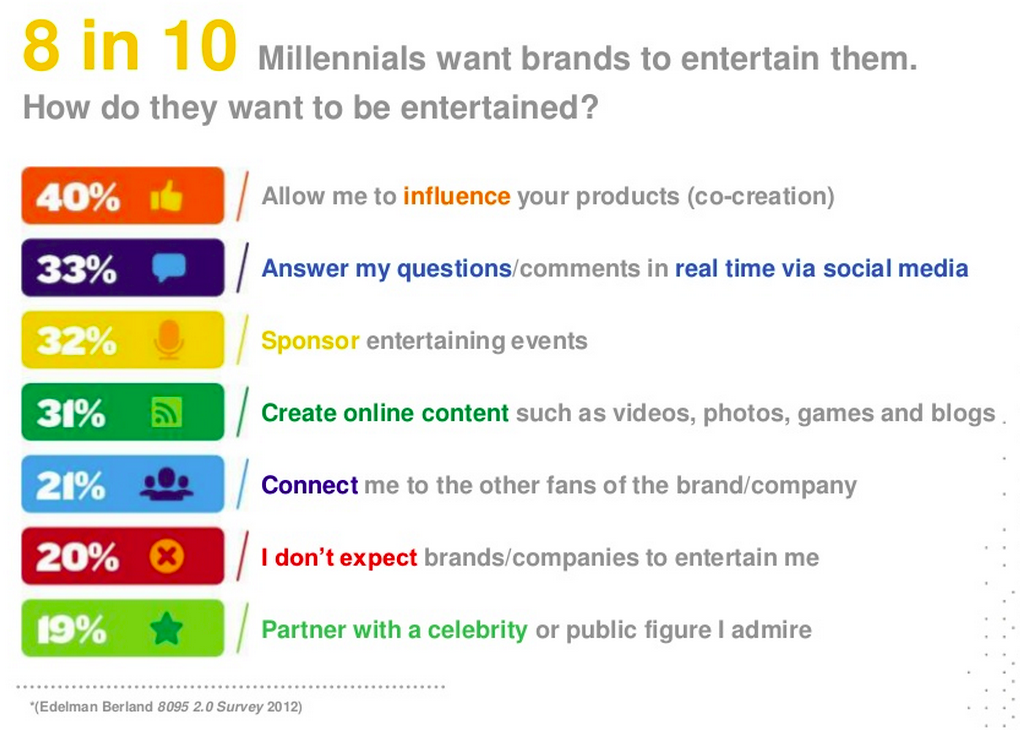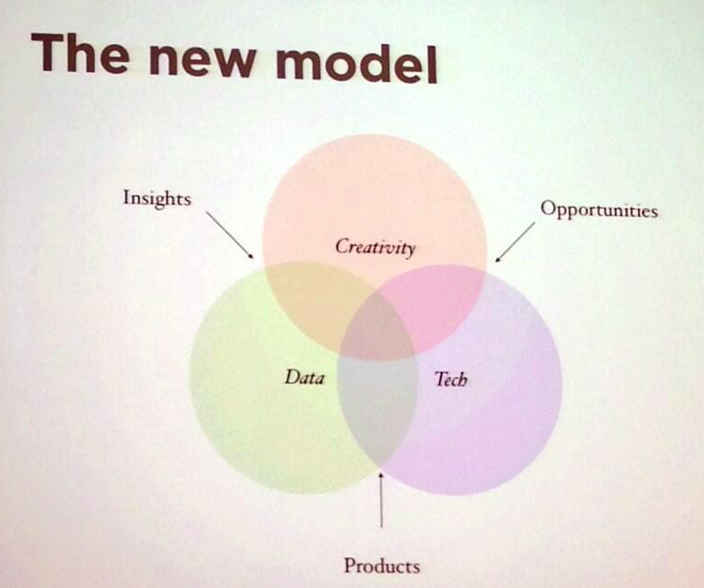iMedia Agency Summit: Day Three
The final day of the 2013 iMedia Agency Summit packed in a host of useful sessions; here are some of the highlights.
Sunita Kaur, Spotify
Sunita stirred the audience with a glorious statistic: “Family and music are the two things people around the world can’t live without. In Europe, research shows that people value music more than they value sex.”
Ant Hearne, Outbrain
Ant began by asserting that content is the glue that brings the internet together, and shared some of his favourite examples of content marketing, including American Express’s OPEN Forum, General Electric’s collaboration with The Economist, and Red Bull Stratos. He went on to assert that 8 out of 10 people will take action on behalf of brands they admire, noting (with some help from Edelman) that content can play a big part in driving this admiration and connection, especially amongst youth audiences:
source: Edelman 8095 Exchange v2.0
However, Ant stressed the need to make sure people understood what was authentic content and what was merely camouflaged ‘brand propaganda’. He added that the brands that will win in a content age will plan around influence, and not interruption. Ant concluded with his 5 pillars of Effective Content Marketing:
- Trust
- Transparency
- Engagement
- Community
- Audience Value
Client Marketer Panel
One of the richest sessions of the day was a panel featuring Laura Ashton, Vice President, Head of Marketing at Philips Lighting; Frederique ‘Freddie’ Covington, CMO Lead, Asia Pacific at Microsoft, Neil Gardner, CMO, APAC at AIG, and hosted by Yean Cheong of IPG Mediabrands.
Laura began by asserting that agencies need to put themselves in their clients’ shoes more often, and spend more time thinking about what will add value to their businesses, not just the agency’s awards submissions. However, she balanced this by saying that it was often difficult for marketers to choose the best route, citing the “tyranny of quarterly results” as one of the toughest parts of the client-side job.
Neil Gardner shared his belief that technology and tools are “eating up” a large part of the media industry’s offering, and that disintermediation appears to be accelerating. Freddie affirmed this, stating that Microsoft is increasingly looking to build agency skillsets in-house, and as a result, the agency’s role needs to evolve into a value-add “creator and curator of opportunities”.
However, all acknowledged that there’s a distinct ‘digital divide’ amongst client-side marketers, separating those who have already embraced all things digital, and those who continue to be scared and skeptical. One way to tackle this is to bring digital into the planning process much earlier so that digital elements can be woven into the broader value offering, rather than continuing to be a last-minute bolt-on [sadly, many of the delegates still feel that this is the way many brands operate, even after 15 years of digital marketing].
Another big step will be to make sure that data plays a more integral part in planning; “Advertising isn’t just about Don Draper anymore,” Freddie said; “we need the Chief Data Officer too. That’s not to say that the creative isn’t vital of course; it’s just that data can help the creativity work a lot harder.” Laura added that Big Ideas are all very well, but agencies must demonstrate how they’re adding to the P&L. “Big Ideas need to be accountable, not just creative,” she concluded.
This means agencies need to hire new kinds of people too: “Agencies can’t rely on the Fine Arts grads anymore,” Laura observed; “you’re going to need tech and data experts too.”
However, the panelists went on to say that staff consistency is key to building enduring client relationships, and agencies are struggling to keep their best digital talent for long enough. Freddie highlighted that part of this may be down to staff review processes: “The ‘annual review’ is totally out of date. Digital pioneers tend to be younger, and they’re hungry and ambitious. They’re not going to wait 12 months for a review; we need to be guiding them and mentoring them at least every 3 months.“
We need more training for senior marketers too. Understanding the tools and the tech is one thing, but Neil also thinks it’s a matter of softer skills. “Young people today don’t think and behave like they did 30 years ago [when most senior marketers were that age].” We need to cater to today’s needs and wants, not to our past dreams.
Freddie also asserted that, when it comes to making better use of digital, we need to stop trying to adapt existing paradigms, formats and approaches: “Stop making analogies to old-school marketing, and focus on today’s ROI and results.“
Vikas Gulati, Vserv
Vikas made the superb point that “many Asians have only ever experienced the web on mobile, so we need to (re)design experiences specifically for them, instead of trying to adapt legacy approaches and structures.” He went on to add that the ‘3Rs’ – reason, relevance and richness – are key to engaging with people in mobile, and that brands need to deliver a more wholly integrated experience. He also noted that local language and cultural aspects are critical, especially in emerging markets where fluency in English is often very limited.
Vikas also highlighted that diversity of technology is a critical factor around Asia, with more than 2,000 smartphone models currently on sale in Asia’s emerging markets alone. Because of this, brands need to be platform agnostic; today’s marketers need to think less about native apps, and more about the fluidity offered by technologies such as HTML5.
He concluded by noting that analysing mobile data doesn’t just mean collecting media data; marketers need to get a better understanding of actual usage behaviour too, and find ways to innovate and disrupt for the audience’s benefit. By collaborating with partners across the mobile ecosystem, brands and agencies have a better chance of delivering lasting, meaningful results.
Meera Chopra, Vuclip
Meera noted that in emerging markets, many people are still sharing links to content via SMS. On Her company’s platform, 20% of all video sharing takes place via text message, which has even more significance when combined with the fact that 60% of women in India use their mobile phone as their primary source of entertainment.
Revolutionising The Agency Of Tomorrow
The Summit concluded with two presentations on how agencies can innovate structures and approaches to be better suited to the opportunities of tomorrow.
Mike De Souza of Mobext began by challenging delegates with a stark observation:
The old model is broken, but this isn’t news – it’s been happening for a decade. So why aren’t we creating better systems? @mplds #imasummit
— imediasummitasia (@iMediaSummit) August 28, 2013
Mike went on to qualify that the reason the old model is broken is that traditional agencies have become too big; “we’re huge multinational hierarchies. We’re risk averse, and we’re too focused on content rather than audience utility.“
One reason we’re failing to deliver more utility is that agencies are still too focused on outbound marketing, rather than looking at a more holistic approach to adding value across our clients’ businesses. Mike remarked that “creativity shouldn’t just be about producing a narrative; it should be about the innovation of systems and value delivery too. We’ve got to move away from the reassuring safety of our traditional templates and formats; we need to stop thinking about making people want things, and shift our approach to making things people really want.“
Mike went on to say that collaboration will be key to future success, whether that involves working with different client teams to create new kinds of value, or it’s about collaboration between specialist agencies that can offer new, distinct value. His advice is to search for “people with similar enthusiasm but diverse skills.“
Mike concluded with a sage piece of advice from Seth Godin:
“As we get more experienced, we get better, more competent, more able to do our thing.
And it’s easy to fall in love with that competence, to appreciate it and protect it. The pitfall? We close ourselves off from possibility.
Possibility, innovation, art–these are endeavors that not only bring the whiff of failure, they also require us to do something we’re not proven to be good at. After all, if we were so good at it that the outcome was assured, there’d be no sense of possibility.
We often stop surprising ourselves (and the market) not because we’re no good anymore, but because we are good. So good that we avoid opportunities that bring possibility.”
Ben Poole of MEC wrapped things up by challenging agencies to rethink the way they structure themselves and their teams. He asserted that ‘big agency bureaucracy’ was the greatest threat to the survival of our industry, and that we desperately need to innovate and disrupt our traditional ways of thinking and doing.
A big part of this, Ben contends, involves rethinking the way we reward people. He questions whether financial incentives are really the best way to motivate creative people, especially when it comes to newer, more innovative disciplines like Creative Technologists.
However, the most important challenge is for agencies to help their clients to change. We’ll need to make marketers more uncomfortable, he says, and find better ways to help them deliver new value. Relationships and trust will still be critical of course, but if we’re to survive as an industry, Ben believes we need to be far more provocative.
I’ll leave you with a great diagram from Mike De Souza that may help to inspire some provocations of your own. Until next year…


